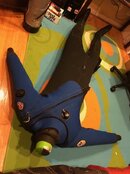TheMunchkin
Registered
Hi, I want to purchase a drysuit but will likely be going the second hand route. I haven't taken the drysuit course due to not having a drysuit of course. So I would like to know what I should be looking for in a drysuit and what I should be avoiding when it comes to second hand, any direction would be greatly appreciated!
Cheers,
JLM
Cheers,
JLM





